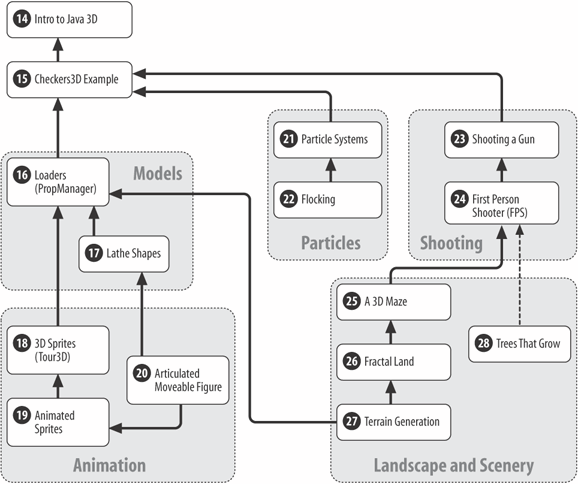A Graphical View of This Book
| This book has four parts: 2D programming, 3D programming with Java 3D, network programming, and two appendixes on installation. The following figures give more details about each one in a visual way. Each oval is a chapter, and the arrows show the main dependencies between the chapters. Chapters on a common theme are grouped inside dotted, rounded gray squares. 2D ProgrammingFigure P-1 shows the 2D-programming chapters. Figure P-1. 2D-programming chapters Chapter 1 is a defense of Java for gaming, which Java zealots can happily skip. The animation framework used in the 2D examples is explained in Chapter 2, followed by two chapters applying it to a simple Worms example, first as a windowed application, then as an applet, then using full screen mode, and almost full screen mode. Chapters 3 and 4 contain timing code for comparing the frame rate speeds of these approaches. Chapters 5 and 6 are about imaging, mostly concentrating on Java 2D. Chapter 6 has three main topics: classes for loading images, visual effects, and animation. Chapters 7 through 10 are about Java Sound: Chapter 8 develops classes for loading and playing WAV and MIDI audio, and Chapters 9 and 10 are on sound effects and music synthesis. A reader who isn't much interested in visual and audio special effects can probably skip the latter half of Chapter 6, and all of Chapters 9 and 10. However, the classes for loading images and audio developed in the first half of Chapter 6 and in Chapter 8 are utilized later. Chapter 11 develops a 2D Sprite class, and applies it in a BugRunner game. Chapter 12 is about side scrollers (as immortalized by Super Mario Bros.), and Chapter 13 is about isometric tile games (Civilization is an example of that genre). 3D ProgrammingThe 3D-programming chapters are shown in Figure P-2. Figure P-2. 3D-programming chapters Java 3D is introduced in Chapter 14, followed by the Checkers3D example in Chapter 15; its checkerboard floor, lighting, and background appear in several later chapters. There are five main subtopics covered in the 3D material: models, animation, particle systems, shooting techniques, and landscape and scenery. Chapter 16 develops two applications, LoaderInfo3D and Loader3D, which show how to load and manipulate externally created 3D models. The PropManager class used in Loader3D is employed in other chapters when an external model is required as part of the scene. Chapter 17 develops a LatheShape class, which allows complex shapes to be generated using surface revolution. A 3D sprite class is described in Chapter 18, leading to a Tour3D application that allows the user to slide and rotate a robot around a scene. Chapters 19 and 20 examine two approaches for animating the parts of a figure: Chapter 19 uses keyframe sequences, and Chapter 20 develops an articulated figure whose limbs can be moved and rotated. Particle systems are a widely used technique in 3D games (e.g., for waterfalls, gushing blood, and explosions to name a few). Chapter 21 explains three different particle systems in Java 3D. Flocking (Chapter 22) gives the individual elements (the particles) more complex behavioral rules and is often used to animate large groups such as crowds, soldiers, and flocks of birds. Lots of games are about shooting things. Chapter 23 shows how to fire a laser beam from a gun situated on a checkerboard floor. Chapter 24 places the gun in your hand (i.e., an FPS). The 3D chapters end with landscape and scenery creation. Chapter 25 describes how to generate a 3D maze from a text file specification. Chapter 26 generates landscapes using fractals, and Chapter 27 uses a popular terrain generation package, Terragen, to create a landscape, which is then imported into the Java 3D application. Chapter 27 discusses two techniques for filling the landscape with scenery (e.g., bushes, trees, and castles). Chapter 28 concentrates on how to make trees grow realistically over a period of time. The dotted arrow from Chapters 24 to 28 indicates a less pronounced dependency; I only reuse the code for moving the user's viewpoint. Network ProgrammingFigure P-3 shows the network-programming chapters. Figure P-3. Network programming chapters Chapter 29 supplies information on networking fundamentals (e.g., the client/server and peer-to-peer models), and explains basic network programming with sockets, URLs, and servlets. Chapter 30 looks at three chat variants: one using a client/server model, one employing multicasting, and one chatting with servlets. Chapter 31 describes a networked version of the FourByFour application, a turn-based game demo in the Java 3D distribution. It requires a knowledge of Java 3D. Chapter 32 revisits the Tour3D application of Chapter 18 (the robot moving about a checkerboard) and adds networking to allow multiple users to share the world. I discuss some of the advanced issues concerning networked virtual environments (NVEs), of which NetTour3D is an example. The AppendixesThe appendixes are shown in Figure P-4. Figure P-4. The appendixes Appendix A describes install4j, a cross-platform tool for creating native installers for Java applications. Appendix B is about Java Web Start (JWS), a web-enabled installer for Java applications. Both appendixes use the same two examples. BugRunner (from Chapter 11, which discusses 2D sprites) uses the standard parts of J2SE and the J3DTimer class from Java 3D. Checkers3D, from Chapter 15, is my first Java 3D example. |
EAN: 2147483647
Pages: 340